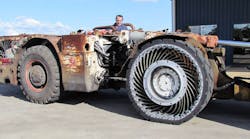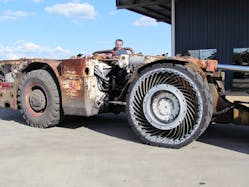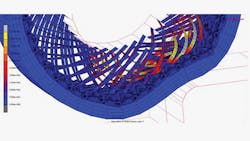Inflated and solid tires could go the way of the buggy whip, at least for off-road vehicles. Engineers at Big Tyre, an Australian firm that designs and manufactures heavy-duty tires for mining vehicles, has developed a new tire design that combines composites, metal, and rubber. It consists of composite leaf springs attached to a steel hub on one end and to steel or fiber segments that hold the rubber tread on the other. The leaf springs are four times as flexible as steel and symmetrically support the hub.
Of course, there’s no risk of puncture. The design also reduces heat entrapment and is expected to handle greater loads, speeds, hauling distances, and last longer than pneumatic tires. And the leaf springs still provide a smooth ride. It will also have the durability of a solid tire.
Simulation played a big role in the design. When engineers built a full-sized prototype of the leaf-spring design, they discovered their FEA software could not model the rubber components when they bulged under load.
To properly simulate the performance of the new tire, engineers had to model the contact between the springs and spring segments and between the rubber and the road; the glued contacts between the segments and the rubber; and the self-contact of the springs. They also needed to address the hyperelastic behavior of the rubber, the large deformation and (deliberate) buckling of the springs, and the material properties of the composite leaf springs.
An outside firm, Compumod, Australia, simulated the leaf-spring design with Marc nonlinear simulation software from MSC Software, Newport Beach, Calif. The analysis program can remesh during an analysis, which lets it handle the excessive strain in the tire’s rubber components.
The consultants first conducted nonlinear static analysis on one spring to correlate material properties with experimental data. The material properties were tuned to replicate the reaction force measured in the experiment. Then nonlinear analysis on the entire wheel determined its strength.
Analysts gave the wheel an enforced displacement of 150 mm, which was solved in 100 nonlinear increments. They then measured the reaction force on the ground and graphed it against displacement. Results indicated the wheel would fail at 252 kN or 25.7 metric tons, well over the target of 16 metric tons.


